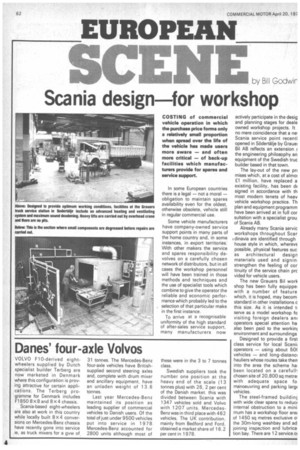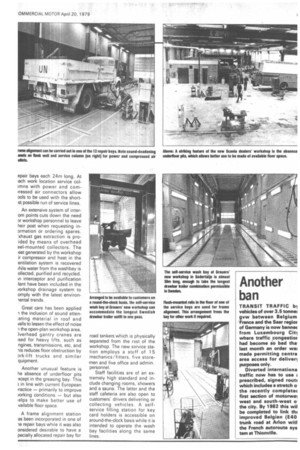Scania design for workshop
Page 64

Page 65

If you've noticed an error in this article please click here to report it so we can fix it.
by Bill Godwir
COSTING of commercial vehicle operation in which the purchase price forms only a relatively small proportion when spread over the life of the vehicle has made users more aware — and often more critical — of back-up facilities which manufacturers provide for spares and service support.
In some European countries there is a legal — not a moral — obligation to maintain spares availability even for the oldest, otherwise obsolete, vehicle still in regular commercial use.
Some vehicle manufacturers have company-owned service support points in many parts of the home country and, in some instances, in export territories. With other makers the service and spares responsibility devolves on a carefully chosen network of distributors, but in all cases the workshop personnel will have been trained in those methods and techniques and the use of specialist tools which combine to give the operator the reliable and economic performance which probably led to the selection of that particular make in the first instance.
To arrive at a recognisable uniformity of the high standard of after-sales service support, many manufacturers now actively participate in the desig and planning stages for deale owned workshop projects. It no mere coincidence that a ne' Scania service point recent' opened in Sodertalje by Grauei Bil AB reflects an extension c the engineering philosophy an equipment of the Swedish truc builder based in that town.
The lay-out of the new pn mises which, at a cost of aim: £1 million, have replaced a existing facility, has been d( signed in accordance with th most modern tenets of heav vehicle workshop practice. Th plan and equipment programm have been arrived at in full cor sultation with a specialist grou of Scania AB.
Already many Scania servic workshops throughout Scar idinavia are identified through house style in which, wherev€ possible, physical features suc as architectural design materials used and signin strengthen the feeling of cor tinuity of the service chain prc vided for vehicle users.
The new Grauers Bil work shop has been fully equippe. with a number of feature which, it is hoped, may becom standard in other installations c this size. As it is intended t, serve as a model workshop fo visiting foreign dealers am operators special attention ha also been paid to the workin! environment and surroundings Designed to provide a first class service for local Scanii operators — using about 50( vehicles — and long-distanci hauliers whose routes take then into the area the scheme ha been located on a carefull, chosen site of 20,800 sq metre, with adequate space fo manoeuvring and parking largc vehicles.
The steel-framed buildinc with wide clear spans to reduci internal obstruction to a mini mum has a workshop floor are of 1450 sq metres exclusive o. the 30m-long washbay and ad joining inspection and lubrica tion bay. There are 12 service oi epair bays each 24m long. At ,ach work location service colimns with power and corniressed air connectors allow Dols to be used with the shortst possible run of service lines.
An extensive system of interom points cuts down the need Dr workshop personnel to leave heir post when requesting inDrmation or ordering spares. :xhaust gas extraction is proided by means of overhead eel-mounted collectors. The leat generated by the workshop ir compressor and heat in the entilation system is recovered rhile water from the washbay is ollected, purified and recycled.
■ n interceptor and purification "ant have been included in the ,torkshop drainage system to omply with the latest environiental trends.
Great care has been applied the inclusion of sound atten,ating material in roof and vas to lessen the effect of noise the open-plan workshop area. Nerhead gantry cranes are Ised for heavy lifts, such as ngines, transmissions, etc, and is reduces floor obstruction by Drk-lift trucks and similar quipment.
Another unusual feature is he absence of underfloor pits .xcept in the greasing bay. This ; in line with current European ■ ractice — primarily to improve forking conditions — but also lelps to make better use of vailable floor space.
A frame alignment station as been incorporated in one of le repair bays while it was also onsidered desirable to have a pecially allocated repair bay for road tankers which is physically separated from the rest of the workshop. The new service station employs a stEff of 1 5 mechanics/fitters, five storemen and five office and admin. personnel.
Staff facilities are of an extremely high standard and include changing rooms, showers and a sauna. The latter and the staff cafeteria are also open to customers' drivers delivering or collecting vehicles. A selfservice filling station for key card holders is accessible on around-the-clock basis while it is intended to operate the wash bay facilities along the same lines.












































































































